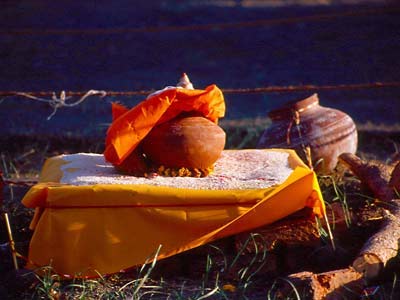
Romola Butalia writes about the history, significance, culture and colour of the Kumbha, the largest spiritual congregation on earth.
The Kumbha Festivals are the largest gathering of humanity on Earth. They speak of an ancient living tradition, of time-honoured rituals, of a cultural heritage that lives and breathes through centuries of time. Some historians trace its origin to the 13th century, others to the 7th century. The Kumbha is an amazing and spectacular spiritual congregation, replete with ritual and fanfare, discourses and prayers, yagnas, bhajans and kirtans, traditionally the most diverse and powerful of all festivals in India.
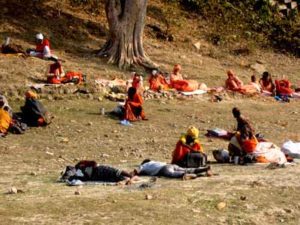 Legend has it that the renowned sage Durvasa visited Amravati in Indralok and presented Indra, the ruler of the celestial regions, with a garland of eternal flowers. Indra, casually passed the garland to the divine elephant, Airawat, under whose feet it got crushed. Durvasa, known for his wrath, cursed Indra that he would be deprived of his powers and his position. T he demon king Bali attacked and overcame Indra. The gods pleaded with Vishnu, who recommended the divine nectar, Amrita, which bestows immortality.
Legend has it that the renowned sage Durvasa visited Amravati in Indralok and presented Indra, the ruler of the celestial regions, with a garland of eternal flowers. Indra, casually passed the garland to the divine elephant, Airawat, under whose feet it got crushed. Durvasa, known for his wrath, cursed Indra that he would be deprived of his powers and his position. T he demon king Bali attacked and overcame Indra. The gods pleaded with Vishnu, who recommended the divine nectar, Amrita, which bestows immortality.
To extract this, the oceans were churned at once by the gods and the asuras. The pot of ambrosia was handed to Brihaspati, (Jupiter) Surya,(Sun) Chandrama (Moon) and Shani (Saturn). In the process of the ensuing tussle to get it, which lasted 12 god-days, equal to 12 human years, a few drops spilled from the kumbh or pitcher in which the Amrita was being carried. This nectar fell at Allahabad, Haridwar, Nasik and Ujjain, sanctifying these places.
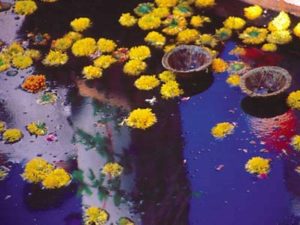 The Kumbha Mela is held at these four sacred places – on the banks of the holy Ganga at Haridwar where it descends from the mighty Himalayas to the plains of India, at the confluence of the Ganga, Yamuna and the mythical Saraswati called the Triveni Sangam at Prayag or Allahabad, beside the river Kshipra at Ujjain and on the banks of the Godavari at Nasik.
The Kumbha Mela is held at these four sacred places – on the banks of the holy Ganga at Haridwar where it descends from the mighty Himalayas to the plains of India, at the confluence of the Ganga, Yamuna and the mythical Saraswati called the Triveni Sangam at Prayag or Allahabad, beside the river Kshipra at Ujjain and on the banks of the Godavari at Nasik.
At each of the four places the Kumbh festival is celebrated once every twelve years, coinciding with one round of Jupiter through the zodiac. Since the three cosmic powers played their role, the Kumbha is celebrated when Jupiter, the Sun and Moon are in particular astrological positions in the almanac.
When the Sun enters Mesh Rashi and Jupiter enters Kumbha Rashi in the month of Vaishakhi, it is held at Haridwar, where The Purna Kumbha was last celebrated in 2010 and the Ardha Kumbha in 2016.
In the month of Magh (Jan-Feb) when the sun enters Makar Rashi and Jupiter enters Mesh Rashi and Vrishabh Rashi, it is celebrated at Prayag, Allahabad, where the last Maha Kumbha Mela was held in 2013. The coming Ardha Kumbha Mela here begins on 15th January 2019.
The Kumbha Mela at Ujjain and Nasik are known as Simhastha because various planets transit in Simha Rashi (Zodiac Leo). When the Sun enters Mesh Rashi (Aries) and Jupiter enters Simha Rashi, the Kumbha is celebrated at Nasik, where it was last celebrated in July-August 2015.
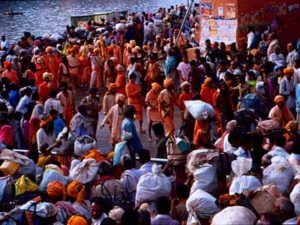 It is celebrated at Ujjain when Jupiter enters Leo and there is a combination of 10 Punyaprad Yog or various specified factors. The Ujjain Simhastha was celebrated in the summer of 2016.
It is celebrated at Ujjain when Jupiter enters Leo and there is a combination of 10 Punyaprad Yog or various specified factors. The Ujjain Simhastha was celebrated in the summer of 2016.
Kumbha procession defies description – it must be experienced to be known. It is heralded by the conjunction of planets at an auspicious time and place, and it is the convergence of a spiritual energy that has it’s own compelling power. The colour and style of the traditional dresses of every region of India intermingle here against the backdrop of shades of saffron everywhere. Sadhus and sannyasins of every kind are represented here in the many colours and images: saffron and pure white, red and black, matted locks, shaved heads; ashes and sandalwood, vermillion and orange pastes; kopins, robes, digambar or sky-clad; sacred beads, stones, glass and metal in necklaces, amulets, bracelets, rings; large kundals through pierced ears; trishuls, machetes, swords and weapons of a different age; the kamadhenu or mendicants bowl, khappar or coconut shell receptacle; flower-bedecked; flags, chattris and palanquins – ceremonial processions and age-old rituals…
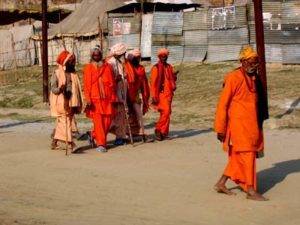 The sounds of the war-like cries of ash-smeared Naga sadhus intermingle with the many sounds in the congregation of elephants, camels and horses as though time has stood still for centuries. The beating drums, the ringing bells, the blowing conch shells and the chants are a strange call of the stirring soul. And in this relentless march is a vibrancy and an energy impossible to define.
The sounds of the war-like cries of ash-smeared Naga sadhus intermingle with the many sounds in the congregation of elephants, camels and horses as though time has stood still for centuries. The beating drums, the ringing bells, the blowing conch shells and the chants are a strange call of the stirring soul. And in this relentless march is a vibrancy and an energy impossible to define.
In recent years, with current trends, the Kumbha Melas have attracted high media attention, international participation and celebrity status as an ‘event’. There have been events that have marred remembrances of the Kumbha. Yet, for the devout, it remains an occasion to be cleansed and purified. For the tourist, it has colour, flavour, exotica. For the spiritually inclined it is a power-house of spiritual energy, the greatest melting pot of transcended egos, where there always exists the possibility of darshan and the crossing of milestones on the path.
What attracts people from all corners of India, and of the world, to participate in the largest religious congregation on earth? As each Kumbha Mela draws near, the drumbeats that hearken those who hear their silent vibrations in their heart, is the awakening of samskaras that are ancient and seemingly coded in our very genes. Without advertisement, the call of the Kumbha is heard, and the relentless march of the faithful gathers force yet again in celebration and in worship.
For a little while, time stands still as an entire city of tents comes up, lives out its destined time, and is razed to the ground once again, in replication of creation, preservation and dissolution.
Main Snan (Bathing) Dates
At Prayag (Allahabad) in 2019 the Kumbha will be celebrated from 15th of January till 4th of March. Important dates of Ardh Kumbh Mela 2019:
| Date (2019) | Day | Event |
| 15th January | Tuesday | Makar Sankranti (1st Shahi Snan) |
| 21st January | Monday | Paush Purnima |
| 4th February | Monday | Mauni Amavasya (2nd Shahi Snan) |
| 10th February | Sunday | Basant Panchami (3rd Shahi Snan) |
| 19th February | Tuesday | Magh Poornima |
| 4th March | Monday | Maha Shivratri |
Photo Credit: Alok Johri

Leave a Reply